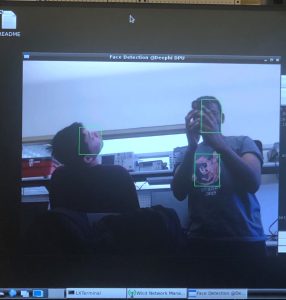Jerry:
Firstly, I was able to set up the board to be accessible without needing a monitor. This would increase our flexibility for working with the board.
I have also been researching into the low power suspend mode and other options for reducing the Ultra96’s power consumption. We discovered that the Linux built-in suspend probably doesn’t power gate the FPGA fabric, as power consumption only falls by half when suspended. There is a chance that the low power suspend requires more deep level tweaking with Vivado (in particular, enabling the option), though we plan to try out the steps afterward in case the DNNDK image also has it enabled.
Since we as a team were able to run various demo CV algorithms with the board, the logical next step will be to try to load our own network on it.
Karthik:
Throughout this week, I helped Jerry and Nathan with trying to set up Deephi on the Ultra96. This took a considerable amount of effort because of some extra time that we needed to debug some issues with transferring the correct files to the Ultra96 board. Specifically, we first tried to use USB, but that didn’t work because the USB was not mounted. Because of this we eventually started to use the wifi connection to the Ultra96 to make an SFTP connection and transfer the Deephi files that way. Eventually, we got it to work and here is a picture with us using one of the face detection demos.

On top of that, we recently acquired the servos that we are going to be using for the project. So, I have started to think about and look into ways to try and interface with the servo motors. Overall, I think I might be slightly behind schedule, but I think a simple demo with a valid control algorithm for the servos should help me get back on schedule.
Nathan:
During, the earlier part of this week, I spent the majority of my time working on finalizing the system details for the Design Report. We decided to use an Adafruit Feather board to control the motors and servos, with controls coming from the Ultra96. I investigated the differences between Circuit Python and Arduino C for the control logic. My initial inclination is to use Arduino C for the sake of portability, and I will try to get a demo working by the end of tomorrow.
I also ordered the last of the components for the mechanical control system, including the Feather board and control board accessories. On top of that, I ordered the lens, however, the vendor is apparently shady about the shipping info, so it’ll take about a week longer than intended for it to arrive. In the meantime, I’ll focus on the servo control, which points the camera at the subject.
P.S. I have been investigating machining the enclosure for the camera at the CMU makerspace instead of buying it. Would save ~$100 and 2 weeks shipping time. None of us have such experience, but we can seek advice.
Team Status Report:
Most of our time this week was spent debugging different issues while trying to run the Deephi demos on the Ultra96. The first issues started with the wifi. Specifically the wifi software that our archlinux OS used had a bug which stopped it from working with wifi networks that used WPA2 security. Our first attempt to get around involved installing a new wifi GUI that would allow us to connect to networks that used WPA2 security. However, after doing that, we were unable to connect to any wifi networks. So, eventually, after trying to fix the issue multiple times, we were able to get it working by hard-reseting, unplugging all of the peripheral devices and reflashing the archlinux OS on the SD card.
We also tried looking into ways to profile the power usage of the board. We could get a crude figure for system power just by looking at the current draw from the power source, though we’d have to find a way to adapt this approach to work with the dedicated DC adapter. We tried installing powertop to get a more detailed breakdown, but the utility wasn’t able to show any power usage statistics. Next we plan to try insalling some tools from Xilinx to get a better idea about the power usage.